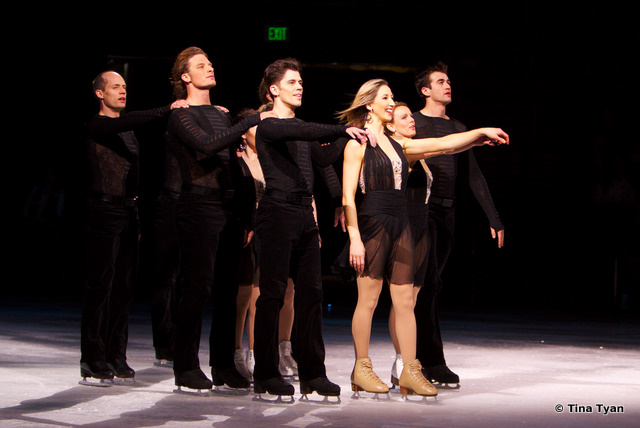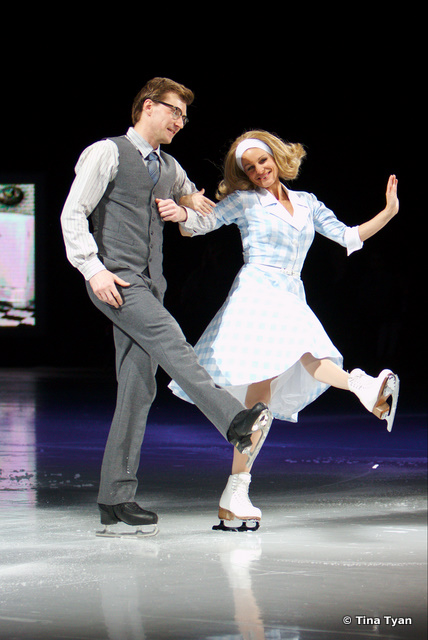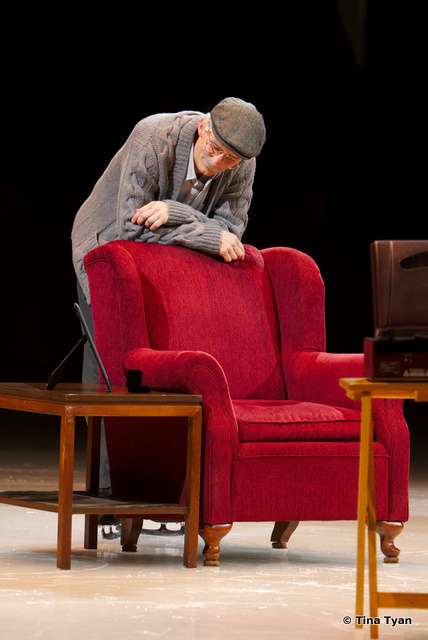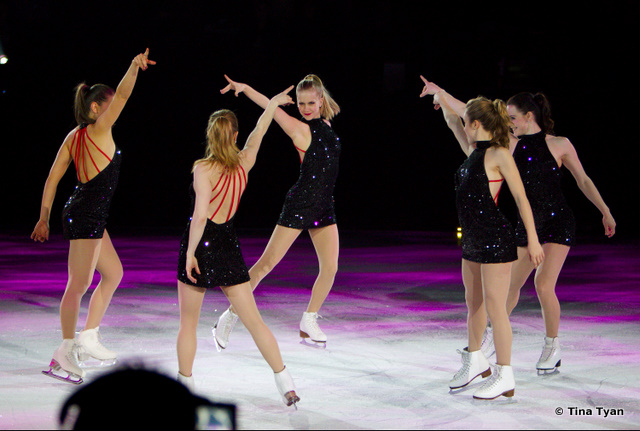Kurt Browning had a vision - the making of the 2012 Stars on Ice show
September 20, 2012
By Tina Tyan
Photos © Tina Tyan
Part 1

Kurt Browning had a vision.
After 22 years of skating in Stars on Ice, the four-time World champion went to tour producer IMG with a clear picture in his head of the show he wanted to create. He had concepts for group numbers, transitions, and choreography already mapped out. A whole show, laid out and ready to go.
The 2012 Stars on Ice "Love 'n Life" tour - critically acclaimed, hailed by many fans as one of the best, most cohesive shows in recent years - is not that show.
"Love 'n Life" is what happened when reality, in the form of a severely constrained budget and limited rehearsal time, forced the first-time choreographer to scrap his original plans and come up with a whole new show.
It is also what happens when a highly creative and committed mind is determined to maintain the quality and feel of a Stars on Ice show, in spite of the substantial barriers in his way.
In 2012, the US Stars on Ice tour had no title sponsor and a significantly slashed budget. As a consequence, there were only three days of rehearsal to put the show, with its multiple complex ensembles and transitions, together. By contrast, at its peak, Stars on Ice used to have at least three weeks of rehearsal and tech time. [for reviews of the shows, click here and here]

Kurt laughs now, recalling how outraged he was one year when former head Stars on Ice choreographer Sandra Bezic decided to add a group number late in rehearsals.
"I remember Sandra wanted [1998 Olympic champion] Tara Lipinski and I to do a group number, and she brought us in and pitched this idea she wanted us to skate together," he said. "And I was so mad because we only had five days left in rehearsal. Was she crazy? Why did she wait so late?”
In those days, rehearsals were followed by a week of tech time in Lake Placid, which meant that ultimately Kurt and Tara had 12-13 days to learn that number. Fast-forward to 2012, when he had to put an entire show together in 3 days, and Kurt can only shake his head in amusement at his past anger at having so little time to do that one number.
He continued, "If you have 3 weeks to write a report, you'll take 3 weeks. If you have 3 hours, you'll take 3 hours. And we know that, but I didn't want...did NOT want the quality to drop."

Originally, Kurt had taken on the role of Stars on Ice choreographer with the idea that it would be his opportunity to put in play a number of ideas that he'd been itching to do for quite some time.
"I thought when I got the job - when they gave me the job - that it would be a one-time deal, that I would just choreograph Stars and do my ideas. Then that didn't happen 'cause the choreography time was too short and we had no title sponsor. So I had to come up with a new show," he said.
With his back against the wall, Kurt was forced to get inventive. Knowing that he would have very limited time to work with his skaters in person, he did a lot of advance planning and preparation. With the help of his three Jeff's - actor/musician Geoffrey Tyler, figure skater/choreographer Jeffrey Buttle, and co-director/costume designer Jef Billings - he worked out the theme, music, concepts, and choreography early in the fall.

In approaching the choreography, he refused to let the quality slip or to simplify the choreography in the interest of expediency or time.
"I was very committed to giving my skaters a show they would be proud of. And scared of a little bit, so that they would be in the tunnel, and focusing on the task at hand, and not 'what are we going to do afterwards?'" he said.
"You know, it's good to push the skaters a little bit. I think it was [Stars on Ice founder] Scott Hamilton that said, 'You win Worlds, and then you go to Stars to get better'. I always liked that. And I think it's true. That you should be a World champion but you still should have lots to learn, and Stars should be able to give it to you."
However, three days of rehearsal is hardly sufficient for the cast to learn five complex group numbers and six inter-number transitions. Kurt found an effective, if extremely time-consuming, solution to this problem by filming himself skating every single part, and sending the recordings to the skaters in advance.

"The secret was the DVDs that I sent out to all the skaters. And bugging them to watch it," he said. "And the US and Canadian cast that didn't really spend the time doing their homework were left in the dust and held us back. The DVDs really worked."
There were trade-offs to this approach, of course.
"With the DVDs, you lose the creativity of the moment. You've sort of committed yourself to these steps because 10 people showed up knowing them," he explained. "So I had to commit, in late November, to the moves that we did in Toronto [in May]. I surprised a lot of people by being extremely organized... I had 85% of the steps all done Nov. 30, and on DVDs and sent out to the skaters. I had to."

Inevitably, once the skaters came together on the ice, adjustments had to be made. Knowing the cast in advance, Kurt was able to choreograph with particular skaters in mind for particular moments or steps. The flip side of designing choreography around specific skaters ahead of time was that sometimes those concepts had to be changed because of those skaters.
"I had this great idea where Sasha [Cohen] was going to do something similar to when the guys lifted her, and she had no skates on [from the 2007-2008 tour], in the beginning of the finale. But her hip was sore, so that became nothing. And then in Canada I had an idea that maybe Shawn [Sawyer] would do it, but then I looked at Shawn's beginning of his program and I went 'you're doing everything I wanted you to do at the beginning of finale. Now what do I do?'" he laughed.
Some adjustments were due to choreographic inexperience.
"I choreographed a group footwork step for the finale...and I choreographed on the ice what fit for an individual, not what fit for a group of 11 people. So I didn't realize that I needed to be 30 feet wide. Rookie, rookie move," he groaned. "So we got to [Lake] Placid, and it stalled in the corner, and got really slow, and I was just like 'oh my God, this is so stupid. But I'm learning'. So, for the last three shows all I did was take out a few steps and put in a low pivot, and it saved us about 15 feet of ice."

Even after the tour hit the road, Kurt continued to rehearse and tweak the group numbers, especially the "A Life Loved" Act II opening number (inspired by the movie Up). When Stars on Ice moved to Canada, Kurt had a new cast and three more days of rehearsal. He took advantage of the opportunity to make an even bigger change to the show, adding a new ladies' group number and dropping some of the transitions.

"The transitions didn't really work the way we wanted. And in three days, I'm sorry, but something's going to fall through the cracks. So if we had had a week even, we could have looked at the programs that the skaters were supposed to intro to, and realize it wasn't working and step back and have plan B. But with three days, the group numbers were most important, the transitions stayed the way they were," he explained. "The girls were not proud of them, I wasn't proud of them."
"And then in Canada, I wanted the girls to be more powerful and I wanted them to be all together. 'Cause we had the guy transitions and the guys had their number, but the girls didn't seem to have anything," he continued. "There was no DVD for that one 'cause I made it up really late, and it showed. The girls were really struggling with it. And so it wasn't the gift I wanted to give to the girls. I don't think I made them look as good as I could have."

For Kurt, choreographing Stars on Ice means striking a balance between wanting to challenge the skaters and the audience with his vision, and needing to mold the show to the skaters' established personalities and skills. Unlike a theatrical show where the actors fit themselves to roles, the cast of Stars on Ice is comprised of well-known skating champions whose individual personalities and skating style are part of their appeal.

"What's frustrating with a show like this is that you never really have total control over what the skaters bring. And until that happens, you will not have really created a show. The day that you control, like [in musical theater] top to bottom, then you'll see my show. And that probably will never happen, right?" he explained. "So how much can I really manipulate the show, when I can't change the pigment of my paints? It's kind of frustrating. So I choreographed a girls' number and it looks great on two girls that have been training Latin movement all year. The other three girls...Joannie [Rochette] [was] doing a pretty good job, but our two singles skaters kind of got left behind. And that was maybe a bad choice on my part. But then again, if I don't present them with that, then they don't get better. So it's interesting."
When it worked, though, seeing his vision translated successfully onto the ice was immensely rewarding for Kurt. The best example of this was the all men's "Waiting for My Real Life to Begin" number, which Kurt did not choreograph himself.

"You know, the boys' number is the most rewarding part of it. Just the cleanliness and the clarity of my vision coming through Jeffrey Buttle and [dancer] Linda Garneau's choreography. But really knowing that even though I didn't choreograph it, that I would come back and say, 'no I don't like the direction you're going. Erase the last minute and a half. Don't do that with the lights. Start over and keep in this direction.' Then they go, 'ok'. And then I'd skate away and go 'wow, I'm really actually directing. I'm actually telling people what to do. This is so cool!'", he said. "So the best part of the show, I didn't choreograph, ironically. And yet I feel that it was absolutely my vision. Like the lights, and the concept, and the size. The rules of engagement of that whole thing were all me."
Getting his vision right extended to the casting of the number. Although Kurt was one of the four men performing the number in the US cast, he chose not to put himself in it in Canada.
"Some people were not happy that I took myself out of it, but I'm really happy I did. I enjoyed skating it, but I enjoyed watching it even more. And I just felt that the age of those four beautiful boys together, standing there in those lights looking so young and masculine ... it was nice to not have me in it. And I think that as a vision it was more powerful that way," he said.
Go to part 2 .




